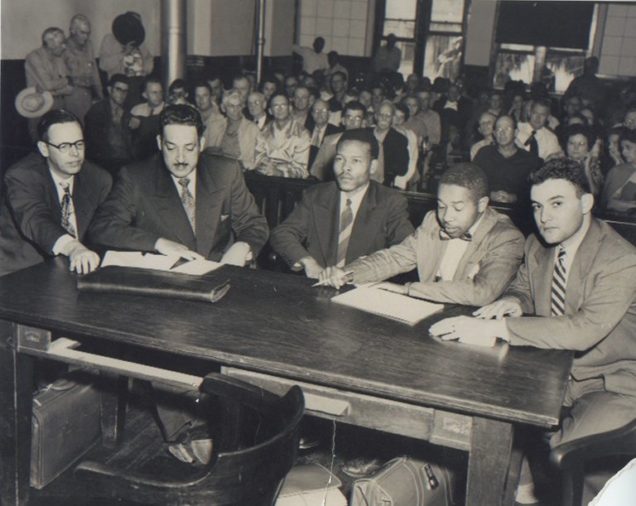Category: State Legislation
Florida Says “Sorry” to the Groveland Four, But Is an Apology Enough?
In April 2017, the Florida legislature passed a resolution (HCR 631) formally apologizing for the unjust prosecution and persecution of the “Groveland Four”, and calling for their exoneration by Governor Rick Scott. The “Groveland Four” is the popularized moniker for Charles Greenlee, Walter Irvin, Samuel Shepherd, and Ernest Thomas; four young black males (age 16 and up) accused of raping a 17-year-old white woman in Groveland, 1948. The infamous case took place during the Jim Crow era, following generations of wrongfully accused, wrongfully prosecuted, wrongfully convicted, and wrongfully executed black citizens. Shortly after they were accused of the crime, Samuel Shepard and Walter Irvin, both World War II veterans, were abducted by law enforcement officers and taken to a secluded spot to be beaten and tortured. After this assault, the deputy officer took Shepard and Irvin to the scene of the crime, only to find that their shoes did not match the footprints that allegedly belonged to the true assailants. Frustrated, the officers took Shepard and Irvin to an interrogation room where they were beaten and tortured until they confessed.
Eventually, Charles Greenlee was picked up by the authorities and subjected to the same treatment a
Shepard and Irvin, but Ernest Thomas caught wind of the investigation and attempted to flee. Thomas’s flight incited a lynch mob, led by both the local sheriff’s department as well as the Ku Klux Klan. The mob not only hunted down and killed Thomas over 200 miles away, but also terrorized the black, segregated section of Groveland, burning down the suspects’ houses and causing numerous black residents to abandon the city in fear. Sheriff Willis McCall, though complicit in stirring up some of chaos, attempted restoring a semblance of order by having the remaining suspects moved from the local jail to the state prison to await trial. The NAACP and the FBI got involved with the case as national attention grew. After documenting the beatings and torture by local law enforcement, the FBI recommended that the Tampa U.S. Attorney General bring charges, but no indictments were made. Franklin Williams of the NAACP represented the remaining suspects, and through his own investigation, suspected the rape accusation was actually a cover-up of a domestic violence incident between the accuser and her boyfriend. During the trial, there was evidence that the suspects had not been in town during the incident and that the footprint (which never matched the suspects’ shoes) was fabricated by the deputy. Still, an all-white jury found Shepard, Irvin, and Greenlee guilty within minutes of deliberating, sentencing Shepard and Irvin to death, and 16-year-old Greenlee to life in prison.
 The United States Supreme Court overturned the capital convictions (Greenlee never appealed) and remanded the case for retrial. Sheriff McCall was transferring Shepard and Irvin back to Lake County (Groveland’s county) for the trial, when McCall claimed he was attacked by the two black men and forced to shoot them in self-defense. Fortunately, Irvin survived the multiple gunshots and told his version of events, which included an unprovoked execution of Shepard and collusion between McCall and his deputy to cover up the failed execution of Irvin. At the retrial, eventual first black Supreme Court justice, Thurgood Marshall represented Irvin, but faced problems similar to the first trial, and Irvin was sentenced to death again. The Florida governor spared Irvin and commuted his sentence to life in prison; Irvin went on to spend 14 years in prison and was released in 1968. He fled Florida for Tennessee, but came to visit Lake County in 1970, where he was found dead in his car. Greenlee was eventually released.
The United States Supreme Court overturned the capital convictions (Greenlee never appealed) and remanded the case for retrial. Sheriff McCall was transferring Shepard and Irvin back to Lake County (Groveland’s county) for the trial, when McCall claimed he was attacked by the two black men and forced to shoot them in self-defense. Fortunately, Irvin survived the multiple gunshots and told his version of events, which included an unprovoked execution of Shepard and collusion between McCall and his deputy to cover up the failed execution of Irvin. At the retrial, eventual first black Supreme Court justice, Thurgood Marshall represented Irvin, but faced problems similar to the first trial, and Irvin was sentenced to death again. The Florida governor spared Irvin and commuted his sentence to life in prison; Irvin went on to spend 14 years in prison and was released in 1968. He fled Florida for Tennessee, but came to visit Lake County in 1970, where he was found dead in his car. Greenlee was eventually released.
The terrible saga of the Groveland Four is only a snippet of the corruption and racism that plagued Lake County, Florida, and the criminal justice system as a whole during and after Jim Crow. Still, this recent formal apology only follows after mounting public pressure to acknowledges the horrendous wrongs of the state. In 2012, the same year Greenlee died, the book Devil in the Grove, which tells the story of the Groveland Four, came out. This book not only renewed interest in the case, but also won a Pulitzer Prize. The book drove a University of Florida student to launch a massive Change.org petition, and with the help of the Miami Herald and Greenlee’s daughter, the matter of an apology and exoneration finally reached a boiling point. Now that an acknowledgment and formal apology has passed the legislature, the wronged accused’s families – and history itself – await the posthumous exoneration by the governor.
If the governor eventually exonerates these innocent African Americans, after waiting over a year to do so, it would follow a growing trend of acknowledging the terrible failures of the criminal justice system and political leaders during the 20th century. However, given the quantity and severity of these failures, should leaders be taking more active steps to right these egregious wrongs, instead of simply apologizing and exonerating? While surviving family members of these victims may be gladdened by a formal acknowledgement of the truth, should they be compensated for their generational pain and suffering, lost wages, even lost earning potential? The impact of these unjust persecutions is not limited to their historical time period, nor to the victims’ families – the community, and even the whole nation, felt the repercussions of these state sanctioned racist acts. These acts also highlight glaring failures of accountability and checks and balances in the criminal justice system. Politicians score political points for acknowledging their state’s past, without taking proactive measures to prevent the same injustices in the future. Civil rights activists believe lawmakers should do more than just apologize, and instead commit resources to ensuring citizens are educated about these dark corners of history, as well as reforming law enforcement offices to ensure accountability and true justice. Others believe that the apologies are not even necessary; what happened in the past should remain there, and present-day America should not apologize for the sins of its fathers. Either way, as the nation reconciles more of these injustices, lawmakers should be thinking of ways to protect their constituents from future injustice.
 Andrea Ogechi-Okoro graduated from Boston University School of Law in May 2018.
Andrea Ogechi-Okoro graduated from Boston University School of Law in May 2018.
States’ Efforts for Veterans Should Be Models
Supreme Court justice Louis Brandeis once called America’s states “laboratories of democracy;” state legislatures can tinker with public policy and, in theory, see what works and doesn’t work. One area where these laboratories are in full swing is in the area of state-level veteran’s benefits.
Many states provide basic benefits, in addition to benefits provided at the federal level, for veterans who serve the nation honorably and meet eligibility criteria. Things like: free admission to parks, hunting and fishing licenses at low or no cost, reduced rates for education at state funded colleges and universities, tax reductions and rebates, and veteran’s preferences for hiring in state jobs, are relatively common. Some states experiment with veteran’s policy by pushing well beyond these common state programs. Texas for example, through the very generous Hazelwood Act, provides up to 150 hours of exemption from tuition for veterans at state colleges and universities, or, if the veteran doesn’t use the benefit, for their spouse or child. Quite a few states (including Massachusetts) fund veteran’s nursing homes and are working to tackle veteran’s homelessness.
All of these programs are impressive and necessary and, they couldn’t be more important. Current veteran suicide rates are staggeringly high. More than seven thousand veterans took their lives in 2014. Of those veterans 70% were not enrolled in the federal VA system. That crisis, coupled with high veteran homelessness rates, poses significant risks to veterans living on the border of, or in, poverty. States address these challenges among their veteran populations in a variety of ways, but it is the way that Massachusetts offers commonwealth veterans in need assistance that show its progressive roots. Roots that stretch back to the Civil War.
During the Civil War, Massachusetts passed Mass. General Law Chapter 115 (Chapter 115). The statute has grown since then, but it has always provided a veteran’s agent in every Commonwealth municipality and assistance with veteran burials and grave services. Today, Chapter 115 benefits still provide a veteran’s agent (now referred to as a veterans service officer or VSO) and cemetery services, but the statute also provides a comprehensive benefit that truly seeks to serve those who have served.
This benefit is probably one of the most effective income-assistance benefits in the nation. It is funded through a city/state partnership where the city’s employee, the Veteran Service Officer (certified and trained by the state Department of Veteran’s Services), uses the regulations promulgated by the state Department of Veteran’s Services (108 Code of Massachusetts Regulation) to makes a determination about the eligibility of the veteran. Initially, if a veteran is eligible for Chapter 115, the veteran’s benefit is paid from the city’s budget. This process makes the Veteran Service Officer accountable to their respective Mayors, City Mangers, and City Councils.
In addition to being accountable to the municipal leadership, when a VSO approves Chapter 115 benefits auditors at the state Department of Veteran Services also reviews the veteran’s file to ensure that eligibility criteria are met and statutory guidelines and obligations are followed. If a VSO denies chapter 115 benefits, or removes a veteran from the program for failure to comply with job searches or income reporting mandates, the veteran can appeal that decision to the state Department of Veteran’s Services (and to higher administrative courts if necessary).
Throughout the veteran’s participation in the Chapter 115 program the Veteran Service Officer has statutory obligations to help the veteran file any and all VA claims and applications for healthcare and other social safety net benefits and to ensure that veterans that are able to work are actively seeking employment and reporting their income to the VSO. Commonwealth VSOs become, throughout this process, the veteran’s advocate, mentor, and coach. Finally, at the end of the fiscal year, 75% of the Chapter 115 benefits that the city pays out are reimbursed by the state Department of Veteran’s Services.
Are Chapter 115 benefits a perfect solution to all the challenges that commonwealth veterans face? Of course not. No government program, non-profit, charity, or business can address all of the complex issues that American veterans deal with. The challenges in transitioning from service in our all-volunteer military to civilian life are serious, but they are surmountable. Examples like the Hazelwood Act and Chapter 115 benefits are just two examples of how to create a net of support for veterans. Other states should look to Texas and Massachusetts to create similar programs, while continuing to experiment.
 Kenneth Meador was an Army combat medic who graduated from the University of Oklahoma and Boston University School of Law (2018). He plans to focus his legal career on helping our nation's veterans.
Kenneth Meador was an Army combat medic who graduated from the University of Oklahoma and Boston University School of Law (2018). He plans to focus his legal career on helping our nation's veterans.
Ballot Initiatives as a Fourth Branch of Government?
The Massachusetts Marijuana Legalization Initiative was a consistent conclusion to the State’s foray into cannabis regulation. Massachusetts decriminalized and legalized cannabis for medical use through ballot initiatives in 2008 and 2012, preparing the public for a controversial and protracted path towards legalization. The success of Question Four raised a multitude of familiar policy questions; what are the legal risks legalizing a federally prohibited substance, or how to entice investor confidence in a cannabis market given the Trump Administration’s regressive cannabis policy? There is also a more democratically existential question: what is the role of the voter initiative, and should this role be celebrated?
The Commonwealth of Massachusetts provides for such direct participation through four ballot initiative forms: law petitions, constitutional amendment petitions, referendum petitions, and public policy petitions. Law petitions, the mechanism most widely understood through the public, are governed by surprisingly straightforward rules. Ballot petitions begin their lives as petitions of law to be adopted by the Legislature. Massachusetts first requires a minimum of ten qualified voters to draft and sign a petition containing the full text of the proposed law for submission to the Attorney General, who returns the petition with a concise summary following confirmation that the subject of the proposal has not violated any Constitutional or procedural requirements. Petitioners then file the proposed law and summary with the Secretary of the Commonwealth, who in return provides signatory forms containing the law’s summary for the gathering of signatures. Assuming that this summary and petition form are returned without challenge, an achievement it its own right, petitioners may then move to acquire the requisite signatures, quantified as “at least . . . 3% of the total vote cast for all candidates for Governor (excluding blanks) at the last state election.”
any Constitutional or procedural requirements. Petitioners then file the proposed law and summary with the Secretary of the Commonwealth, who in return provides signatory forms containing the law’s summary for the gathering of signatures. Assuming that this summary and petition form are returned without challenge, an achievement it its own right, petitioners may then move to acquire the requisite signatures, quantified as “at least . . . 3% of the total vote cast for all candidates for Governor (excluding blanks) at the last state election.”
The ballot initiative process is not designed to circumvent the legislature – at this stage, the legislature considers the petition, without opportunity for amendment, and may ultimately vote for engrossment and delivery to the Governor for final signature. Even at this stage, the democratic power of ballot initiatives is compelling, regardless of whether enactment follows. The legislature may feel increased pressure to address the subject through independent legislation, responding to a newly recognized mandate from the public will, while avoiding the drafting and policy deficiencies sometimes associated ballot initiatives. These responses are not direct responses to the initiative petitions, however. The legislature may only take four actions: enactment, disapproval, inaction, or proposal of a substitute. Any action beside enactment returns the initiative to its petitioners, who upon gathering the requisite number of signatures, puts the question to the voters at the next state-wide election.
Democracy in Action, or a Breakdown in Lawmaking?
The utility of ballot initiatives is more than the results they may yield. Substantive results aside, the evaluation of ballot initiatives is multifaceted. First, ballot initiatives provide an opportunity to spur reactionary legislation, by presenting to legislatures with a choice between engrossing the initiative law petition themselves, pursuing independent legislative action on the matter, or rejecting the measure and resigning its fate to the public’s will.
Second, ballot initiatives provide a path for citizens to democratically express their ideas. Of course, the democratic nature of ballot initiatives says nothing of morality: initiatives range from the laudable measures calling for statewide universal healthcare to the morally insolvent represented by acts like the “Sodomite Suppression Act”, a reprehensible initiative calling for statewide execution of members of the LGBTQ community.
The range of subjects covered by ballot initiatives is nearly limitless, and while most initiatives do not survive long enough to receive a vote from the general public, ballot initiatives remain procedurally significant merely in that they are introduced into the marketplace of ideas. This procedural significance exists regardless of the substantive merits of the initiatives, with democratically compelling state ballot initiative questions like: “should we give $1 million to one random voter?”, “should Denver set up a commission to track aliens?”, and “should we stop selling the Europeans our horse meat?” Regardless of the content of the initiatives, their consideration is itself a democratic virtue and strong argument for the continued use of ballot initiatives.
Third, while ballot initiatives are democratic,they sometimes produce substantively imperfect results. Despite being the will of the people, the substantive terms of the Massachusetts Marijuana Legalization Initiative were short-lived. Towards the end of July 2017, Massachusetts Governor Baker signed into law House No. 3818, An Act to ensure safe access to marijuana. This law amended the voter approved cannabis laws by raising taxes on cannabis from 12% to 20%, altered the scheme in which municipalities could ban legal cannabis sales, and restructured the newly formed Cannabis Control Commission. As a result, although legalization advocates were able to achieve their goal of legalizing cannabis, the regulatory structure was significantly different than originally envisioned.
Ballot Initiatives: The People’s Branch of Government – Truism, or Absurdity?
The debate over the place of ballot initiatives within democracy is ongoing. On one hand, ballot initiatives can be construed as a “fourth branch of government” (or perhaps fifth, for those readers who may also delegate such status to administrative agencies).
 Ballot initiatives allow citizens to circumvent special interests and legislative roadblocks to see their will materialized. Alternatively, although ballot initiatives support the free expression of ideas, they fail to provide an opportunity for consideration and compromise with dissenting views, which is substantially undemocratic. Rather than circumventing special interests, this shortcoming may make ballot initiatives the epitome of special interests, allowing the loudest voices in the room to acquire funding and support on the public sphere, regardless of their relative merits and detractors.
Ballot initiatives allow citizens to circumvent special interests and legislative roadblocks to see their will materialized. Alternatively, although ballot initiatives support the free expression of ideas, they fail to provide an opportunity for consideration and compromise with dissenting views, which is substantially undemocratic. Rather than circumventing special interests, this shortcoming may make ballot initiatives the epitome of special interests, allowing the loudest voices in the room to acquire funding and support on the public sphere, regardless of their relative merits and detractors.
The cannabis ballot initiative saga in Massachusetts presents a compromise between this dichotomy. Ballot initiative lawmaking may indeed represent a new “fourth branch of government” – but a fourth branch that is weaker in its power. As Massachusetts has shown, voter approved laws remain subject to the check and balance of subsequent legislative action, which in turn is checked by traditional balance of powers built into state and federal constitutions. The ballot initiative process has a demonstrable capacity to force legislative action, a democratic strength in its own right.
 Connor Mullen anticipates graduating from Boston University School of Law in May 2018.
Connor Mullen anticipates graduating from Boston University School of Law in May 2018.
Massachusetts’ End of Life Options Bill Elicits Emotional Arguments
“An Act relative to end of life options” is currently being considered in the Massachusetts State House. Six states, including California, Colorado, D.C., Oregon, Vermont, and Washington, have legalized physician-assisted suicide (“PAS”). Massachusetts Representative Lou Kafka and Senator Barbara L’Italien introduced identical bills in Massachusetts’ legislature (H1194 and S1225, respectively) on January 27, 2017. According to Death with Dignity, a 501(c)(3) nonprofit organization and proponent of Massachusetts’ bill, “[t]he 2017-2018 session is the eighth time a Death with Dignity bill is under consideration in the Massachusetts legislature.” A “Death with Dignity” initiative was also voted down by Massachusetts citizens in a November 2, 2012 ballot measure.
The Massachusetts bill would allow a fully-informed “adult of sound mind” with “a terminal illness or condition which can reasonably be expected to cause death within 6 months” to end their life with medication prescribed by a physician. Massachusetts legislators heard “emotional appeals” regarding the bill in a September 2017 joint hearing.
Proponents include Compassion and Choices, “the nation’s oldest, largest and most active nonprofit organization committed to improving care and expanding options for the end of life.”
Compassion and Choices argues:
- Medical aid in dying has strong support from people living with disabilities and offers “autonomy, independence and self-determination.”
- It is a “safe and trusted medical practice” that requires two doctors to confirm a patient is fully informed before providing a prescription for medication.
- Existing laws are overseen by state agencies and “have sound oversight and investigation processes in place.”
- A similar law in Oregon showed improvement in overall end-of-life care.
- The New England Journal of Medicine reports “there are no substantial cost savings,” so there is no financial incentive for insurers to pressure terminally ill patients to end their lives.
- Gallup and The Harris Poll found Americans supported medical aid in dying at a rate of 68 and 74 percent, respectively. Additionally, six states have authorized medical aid in dying.
- A growing number of healthcare professionals have endorsed or accepted medical aid in dying.
Other organizations, such as Second Thoughts Massachusetts and Not Dead Yet, opposed the legalization of PAS, which they consider “a deadly form of discrimination against disabled people.” John Kelly is the director of Second Thoughts and regional director of Not Dead Yet. Proponents, according to Kelly, tend to be those who have been treated well by the healthcare system: white, non-disabled, higher social class—the same types of people who tend to make up the majority of the legislature. In the 2012 Massachusetts ballot measure which voted down PAS, Cambridge and Northampton voted roughly 68 and 73 percent, respectively in favor of PAS. Springfield and Lawrence, however, voted 65 and 69 percent against PAS, respectively. Kelly, who prefers the term “assisted suicide” instead of “medical aid in dying,” offered five additional arguments against the Massachusetts bill:
- Once it becomes one person’s choice, it becomes everyone’s choice; a family can engineer the decision rather than it being solely the decision of the individual.
- Assisted suicide is the cheapest treatment for insurers and, where legal, there are examples of insurers covering suicide, but not treatment.
- The Massachusetts bill requires those seeking PAS to have “a terminal illness or condition which can reasonably be expected to cause death within 6 months.” However, some patients expected to live only six months actually live much longer. According to Kelly, “thousands of people graduate from hospice every year.”
- Those assisting in death are immunized from liability; doctors can write prescriptions with little to no knowledge of the patient; and without a witness requirement, “anyone could take action with impunity.”
- Bias: Suicide requests from people with terminal illness are usually based on fear and depression.” Unlike in the case of a suicidal teenager who is offered suicide prevention services, a terminally ill patient may instead be offered suicide assistance. This is a “deadly” form of discrimination.
Massachusetts’ bill neither confirms nor contradicts Compassion and Choices’ arguments. The bill addresses some, but not all of its opponent’s concerns:
“Once it becomes one person’s choice, it becomes everyone’s choice.” The bill addresses this concern a few ways. First, the bill requires witnesses, the patient, the patient’s attending physician, and a consulting physician to verify the patient is acting voluntarily. See §§ 3(2)(b), 4, 6(1)(a)(iv), 6(1)(c), 7(1)(c)(ii). Next, section 14(1) invalidates any estate provisions hinging on “whether a patient may make or rescind a request for medication.” The bill also provides criminal sanctions and civil liability for misconduct: “[p]urposely or knowingly altering or forging a request. . . without authorization of the patient . . . is punishable as a felony . . .”; “[a]n individual who coerces or exerts undue influence on a patient to request medication . . . shall be guilty of a felony”; and “[n]othing in this act limits further liability for civil damages resulting from other negligent conduct or intentional misconduct by any individual.” §§ 16(1)-(3). It could still be argued, however, that it is difficult to detect “undue influence” as it is sometimes difficult to tell whether an idea is a patient’s or someone else’s.
“Assisted suicide is the cheapest treatment for insurers.” The bill does not appear to address this concern.
Patients diagnosed with a terminal illness can get better. The bill does not appear to address this concern.
The law immunizes from liability those assisting in death. The bill protects the actions of “health care providers and patient advocates supporting a qualified patient” from being construed as “elder abuse, neglect, assisted suicide, mercy killing, or homicide under any civil or criminal law or for purposes of professional disciplinary action.” § 14(4). However, the law also protects against negligence and intentional misconduct, as noted in section 16(3) above.
Bias: a depressed teenager is offered suicide prevention, while a depressed disabled individual may be offered suicide assistance. Section 8(1) requires patient speak to a counselor to “determine that the patient is not suffering from . . . depression causing impaired judgment.” This appears to potentially address Kelly’s concerns; however, this could also be interpreted to allow someone with depression that does not impair judgment to seek life-ending treatment.
Massachusetts’ End of Life Options Bill has additional protections to ensure the informed consent of terminally-ill patients seeking medical aid in dying. For example, the bill requires that such patients make an oral and written request and get approval from four health and counseling professionals, among other requirements. John Kelly, however, argues that the state needs to more-substantially fund mental health and palliative care programs instead. Thus, while this bill may achieve many of the goals of its proponents, it does not do enough to alleviate its opponents’ concerns.
 Kara Morris anticipates graduating from Boston University School of Law in May 2019.
Kara Morris anticipates graduating from Boston University School of Law in May 2019.
Pharmacies Try Their Hand at Opioid Policy
The opioid crisis has continued to grab national attention, as total drug overdoses hit yet another historic high in 2016. One of the nation’s largest pharmacies, CVS, recently joined the debate by announcing a new national opioid policy.
In February 2018, CVS started capping new opioid prescriptions at a seven-day supply. Additionally, CVS is limiting daily doses to 90 morphine milligram equivalents (MME) and requires medical providers to prescribe immediate-release opioids before attempting extended-release versions. The policy itself is unremarkable. CVS is merely adopting the CDC’s prescribing guidelines. In fact, 17 states have done the same or equivalent, including Massachusetts. And while it may appear strange for a retailer like CVS to forcibly limit its own sales, both pharmacies and pharmaceutical companies have faced a growing threat of litigation in recent years over the marketing and sale of prescription opioids.
Medical providers, chronic pain patients, and some drug policy experts have lodged a number of concerns in response to CVS’s new policy. These concerns not only identify some of the closely held interests in the opioid debate but also demonstrate the challenges of developing effective policy against a crisis that is rapidly evolving.
The Costs
Opioid policies fall into three main categories: preventive, treatment, and punitive. The CVS policy aims to prevent the development of new opioid use disorders (OUDs). In an effort to minimize unintended consequences, the policy carves out two administrative exceptions: first, doctors may request exemptions for certain patients, and second, employers and insurers can opt out of the program altogether. The CVS policy also aligns itself with CDC guidelines in exempting patients who are in “active cancer treatment, palliative care, or hospice care.”
While this may reassure cancer patients, other patients with chronic pain have expressed cause for alarm. For one, their access to opioids is already subject to an ongoing and heated debate within the medical community. Limited data on long-term opioid use for chronic pain management has bisected medical experts’ opinions on the evidence base, ethics, and ramifications of prescribing decisions. In 2016, the CDC entered the fray. While its guidelines recommend heavily individualized opioid treatment decisions, the CDC director placed his thumb on the scale by declaring that “[m]anagement of chronic pain is an art and a science. The science of opioids for chronic pain is clear — for the vast majority of patients, the known, serious, and too-often fatal risks far outweigh the unproven and transient benefits.”
Chronic pain patients disagree that the data are so clear-cut. Moreover, they allege that the national opioid narrative is eliciting a fear-based response among medical providers at a negative cost to their treatment. Chronic pain patients report that their providers increasingly treat them like “addicts,” an inappropriately stigmatizing term that in these cases also ignores critical diagnostic differences between substance dependency and a substance use disorder. The result can be forced reductions to a patient’s opioid prescription without warning (known as involuntary tapering) or in extreme cases a blanket office policy against prescribing opioids altogether. It is early days—too early for clear data in fact—but reports of patient suicides in the wake of involuntary tapering have already surfaced.
 The CDC does not expressly require a physician to involuntarily taper a patient off of opioids. In fact, the CDC vests the authority for such individualized prescribing decisions in physicians. However, the DEA, which grants physicians’ prescribing licenses, admittedly muddled that message when it proposed broad cuts to opioid production: a 25% decrease in 2017 and a 20% decrease in 2018. Moreover, punitive DEA actions against physicians regarding opioid prescription conduct increased fivefold between 2011-2016. While the penalties are clear and steep (including loss of medical licensure and criminal charges), what conduct triggers those penalties is less clear. Thus, the combination of liabilities without a clear safe harbor incentivizes an overly strict interpretation of federal policies in ways that may harm patients.
The CDC does not expressly require a physician to involuntarily taper a patient off of opioids. In fact, the CDC vests the authority for such individualized prescribing decisions in physicians. However, the DEA, which grants physicians’ prescribing licenses, admittedly muddled that message when it proposed broad cuts to opioid production: a 25% decrease in 2017 and a 20% decrease in 2018. Moreover, punitive DEA actions against physicians regarding opioid prescription conduct increased fivefold between 2011-2016. While the penalties are clear and steep (including loss of medical licensure and criminal charges), what conduct triggers those penalties is less clear. Thus, the combination of liabilities without a clear safe harbor incentivizes an overly strict interpretation of federal policies in ways that may harm patients.
Beyond the legal liabilities, physicians have also voiced concerns over the increasing intrusion of third parties into treatment decisions. The CVS policy allows a doctor to request exemptions for certain patients, but does not specify its criteria for granting exemptions or if there are caps on the number of exemptions a doctor may request or receive. Some doctors worry the additional administrative requirements to apply for CVS exemptions will burden already overtaxed primary care physicians, leaving patients with delayed or insufficient care. For example, one study found that physicians already spend two hours on paperwork for every hour of treating patients. The CVS policy will increase that paperwork burden for physicians who choose to file for opioid patient exemptions.
Without further research on long-term opioid use, clear safe harbors for prescribing compliance, and a significant increase in the number of medical specialists trained in pain management, some patients and doctors share the concern that this prevention policy will come at unintentional costs to patients with chronic pain.
The Benefits
Much of policy derives from a cost-benefit analysis. If prescription opioids are the source of most new cases of OUDs, then some risk to patients with opioid dependencies (like those managing chronic pain) may arguably be worth strictly limiting their supply. Thus, the $78.5 billion question remains: are prescription opioids presently the main cause of new OUD cases?
A growing subset of drug policy experts say no. While prescription opioids undoubtedly contributed to the opioid epidemic in the past, recent data show that opioid prescriptions continuously decreased from 2010-2015. During that same time span however, opioid mortalities continuously increased. In fact, heroin increasingly represents the initiating opioid of use for new OUD cases, not oxycodone or other prescriptions. These data suggest that the over-prescription of opioids has been largely corrected and that new and stricter prescription limits moving forward may offer only marginal benefits.
The debate over CVS’s initiative mirrors many of the challenges of developing effective opioid policy at the state level. The opioid epidemic is rapidly evolving whereas drafting and passing legislation can take years to accomplish. In that same time span, the drop in prescription rates between 2010-2015 as well as the emergence of heroin as an initiating opioid have shifted the opioid epidemic, throwing into question just recently passed prescription-focused legislation. In short, the opioid crisis is both testing and demonstrating the limits of the legislative process.
Second, even if a legislature could sustain a multi-decade focus on continually revising opioid legislation, any attempt to do so effectively would require massive data gathering. Currently however, state medical examiners have already passed their breaking points, whether from running out of room, running out of money, or burnout. Yet these examiners play a crucial role in accurately identifying the cause of death for overdoses. Thus, even accurately tracking changes in cause of death alone would necessitate a massive influx of resources, in terms of additional personnel, time, and training for standardization. Beyond tracking overdoses, states would furthermore have to allocate additional resources to continuously monitor changes in initiating opioid use and to what extent supply limitations (like those currently placed on prescriptions) result in a substitute demand for more harmful illicit opioids like fentanyl.
Third and finally, the unintended effects of legislation matter just as much as the intended. A complex mesh of societal, punitive, and regulatory forces have created powerful disincentives for physicians to prescribe opioids or treat patients who need them. In particular, the stigmatization of chronic pain patients incentivizes withholding treatment for moralistic rather than medical reasons. The threat of criminal prosecution and loss of medical licensure incentivizes avoiding even relatively benign conduct for fear of triggering DEA or state investigation. Finally, the paperwork barriers formed by each new layer of regulatory compliance incentivize avoiding time-consuming patients, like those who require opioids. Thus, the exemptions that CVS and other state policies designed to safeguard individualized treatment decisions are likely insufficient to counterbalance the opposing disincentives. Effective policymaking requires a careful calculation of both direct and indirect incentives, far beyond the scope of a single prescription policy.
Going forward, CVS (and the states) should consider policy alternatives that expand provider choices rather than restrict them. For example, CVS could begin offering the abuse deterrent formulations (ADFs) of opioids. The FDA recommends ADFs as they offer the same pharmacological benefits as regular opioids but exist in a form that is harder to physically alter for off-label use. Currently, CVS does not cover any of the ten ADFs approved by the FDA. By offering a new prescriptive tool instead of restricting an existing one, this alternative might maintain some of the same intended preventive benefits without triggering an incentive to drop chronic pain patients.
Moreover, the addition of ADF coverage would allow for greater flexibility on a state level. Many states are in the process of or have recently completed crafting comprehensive legislative packages (including combinations of preventive, treatment, and punitive solutions). CVS’s uniform national policy may interfere with these efforts and make addressing unique state needs more challenging than necessary.
In summary, the benefits of CVS’s opioid policy are unlikely to outweigh its harms. The CVS policy provides no new guidance as it merely mimics the existing CDC policy, but it does add new layers of time-consuming compliance for providers pursuing medically-valid exemptions. Pharmacies and other retailers would do better to provide additional support to the existing state and federal opioid infrastructure than begin imposing new requirements upon it.
 Caitlin Scott anticipates graduating Boston University School of Law in May 2019 and plans to practice Health Law.
Caitlin Scott anticipates graduating Boston University School of Law in May 2019 and plans to practice Health Law.
“Am I Free to Go?” – It Depends On Who You Ask
Typically, when criminal proceedings against a person in state or local custody have been settled, he or she is free to go. This can occur either after that the individual's charges have been dismissed, they have posted bail, or their jail sentence has been completed. Yet, for years there has been confusion among states whether exceptions to this process can be made for certain immigrants. The confusion focuses on whether or not state or local law enforcement officials have the authority to detain an immigrant based solely on a request, or detainer, from Immigration and Customs Enforcement (ICE). In other words, is an immigrant free to go once the criminal proceedings have been settled, or do these ICE detainer requests carry some legal weight? The answer to that question changes depending on who you ask.
The Supreme Judicial Court of Massachusetts was recently confronted with this question and on July 24, 2017 it issued a ruling in Commonwealth v. Lunn limiting the ability for state and local law enforcement officials to assist with federal immigration enforcement. To help address the issue, the court proceeded to “look to the long-standing common law of the Commonwealth and to the statutes enacted by our Legislature.” Ultimately, the court concluded that “nothing in the statutes or common law of Massachusetts authorizes court officers to make a civil arrest in these circumstances.” It was this language that presumably opened the door to recent legislation that was filed by Governor Baker August 1, 2017.
According to Governor Baker, this bill “fills the statutory gap identified by the SJC” and “authorizes, but does not require, state and local law enforcement to honor detention requests from Immigration and Customs Enforcement for aliens who pose a threat to public safety.” It attempts to accomplishes this mission, and avoid running up against the holding in Lunn, by narrowing the scope of the legislation. The bill is supposed to establish minimum criteria for an immigrant to be deemed a public safety threat by focusing “on those who have been convicted of serious crimes such as murder, rape, domestic violence and narcotics or human trafficking.” Furthermore, any detention in excess of 12 hours that results from compliance with a detainer request or an administrative warrant would be subject to judicial review. On its face, this bill seems to pass muster with the holding in Lunn and attempts to strike a healthy balance between public safety and immigrant rights, but there are some serious legal and moral issues that this bill either misguidedly collides with or willfully ignores.
First and foremost, the bill does not target only people convicted for atrocious crimes, despite claims to that effect. Under the bills current language, an immigrant can be detained by state or local officials for immigration purposes, if he or she “has engaged in or is suspected of terrorism or espionage, or otherwise poses a danger to national security [emphasis added].” These standards clearly fall short of a conviction. It also allows for detention in cases where “the person has been convicted of an offense of which an element was active participation in a criminal street gang, as defined in 18 U.S.C. § 521(a).” Unfortunately, the methods that many state and local police officials use to identify gang membership, have come under much scrutiny because of their unreliability, lack of transparency, and minimal oversight. In Boston, something as simple as the color of an immigrant’s attire, or as ironic as being the victim of an attack by another gang, can lead police to label an immigrant a gang member. Furthermore, the bill states that a person who has been convicted of an aggravated felony, as defined under 8 U.S.C. § 1101(a)(43), can also be detained. Again, the use of said language can be very misleading and troubling. For the purposes of federal immigration law, Congress has broad latitude to label crimes as aggravated felonies and an offense need not be “aggravated” or a “felony” to be considered an aggravated felony (see 8 USC § 1101(a)(43)). As the ACLU of Massachusetts and the Massachusetts Immigrant and Refugee Advocacy Coalition recently stated in a joint memo, “the premise that any legislation authorizing warrantless detention of immigrants is necessary for public safety is misguided.” Our current laws already provide communities with the necessary tools to take custody of people who pose a danger to public safety and local officials already have procedures for notifying ICE about current detainees.
Equally important to the determination of whether this is a well-crafted and well thought out piece of legislation, is the constitutional analysis of the bill. Importantly, a footnote in the Lunn decision noted that the court “do[es] not address whether such an arrest, if authorized, would be permissible under the United States Constitution or the Massachusetts Declaration of Rights.” And although the court chose “to defer to the Legislature to establish and carefully define” the authority for court officers to arrest for federal civil immigration offenses, it emphasized in an additional footnote that it expressed “no view on the constitutionality of any such statute.” Governor Baker’s bill tries to take advantage of this unanswered question, but unfortunately it would invite costly and unnecessary litigation about its constitutionality if it passes; litigation that would almost certainly hold ICE detainers as unlawful. First, Article 14 of the Massachusetts Declaration of Rights prohibits warrantless arrests for civil infractions. Second, in the case Morales v. Chadbourne the First Circuit court of appeals ruled that detaining a person based solely on an ICE detainer request is a violation of their Fourth Amendment right. The court explained that "[t]o hold otherwise would mean that the approximately 17 million foreign-born United States citizens could automatically be subject to detention and deprivation of their liberty rights."
Although everyone wants to live in a safe community, this bill promotes the false narrative that immigrants are associated with criminality, while further entangling state and local law enforcement in federal immigration enforcement. In the long run, bills such as this one can be dangerous to the administration of justice and to public safety. Although most people would agree that our federal immigration system is broken, states should be careful to protect the civil rights of all its residents.
Mario Paredes anticipates graduating from Boston University School of Law in May 2018.
Kentucky Medical Review Panels: A Toe in the Water of Tort Reform
In March, the 2017 Kentucky General Assembly passed SB4: AN ACT relating to medical review panels. Sponsored by Senator Ralph Alvarado, a physician from Winchester, the bill establishes medical review panels as a first stop for any medical malpractice claim in Kentucky. The new statute provides that, prior to filing a lawsuit for medical malpractice against a health care provider or institution, all claims shall be reviewed by a medical review panel. This post will explore the new law and describe the difficulty of predicting the exact effect that the medical review panel will have on malpractice suits in Kentucky.
To file a medical malpractice suit in a Kentucky court, a complainant must present their potential claim to the panel and have received an opinion regarding their claim. The panel, made up of three healthcare providers and a non-voting attorney chairman, has up to nine months to give its opinion of the malpractice-related claim. The panel can decide that a plaintiff’s case has no merit, that there was a failure by the defendant to provide proper care, or that there was a failure to provide proper care, but the misconduct did not lead to a negative medical result. Regardless of the opinion issued by the panel, the plaintiff may still take their case to court. The opinion issued by the panel is admissible at trial and the doctors on the panel may be called as witnesses.
Why put these hurdles to litigation in place? Critics have long argued that too many meritless medical malpractice claims are filed each year, which causes health care provider liability insurance to skyrocket and encourages the practice of “defensive” medicine. Concerns that too many malpractice claims are “frivolous and request unrealistic damages” date back to the mid-1970’s. Another concern which prompted this change in the law, according to Rep. Robert Benvenuti of Lexington, is that the current medical malpractice process is slow and “drags on for years and years and years [and] it ends by the judge encouraging or sometimes ordering mediation.” According to Benvenuti, the panels speed up the process by putting mediation on the front end.
Kentucky is only the latest in a number of states which have implemented these medical review panels. Medical review panels have been the proposed and implemented solution for the highly litigious area of medical malpractice, but it begs the question, do they actually work? The data varies by state, and the extent of tort reform implemented in different states can make it difficult to determine the effect of just implementing medical review panels. For example, data from the National Association of Insurance Commissioners found that malpractice premiums in California grew much more slowly than the rest of the nation after it passed comprehensive tort reform. Unlike Kentucky, California’s tort reform included caps on non-economic damages, changing payout requirements, limitations on attorney fees, and a required 90-day notice to file a lawsuit, but does not require medical review panels.
 Studies on the isolated effect of just medical review panels are sparse. The most comprehensive study on the effect of medical review panels dates all the way back to 1986, finding that the panels caused an overall increase in the number of disputes, overall costs, and lengthening of time of the process. However, a more recent study commissioned by the American Medical Association (an advocate of tort reform) in 2008 found that states with screening panels generally medical liability insurance rates 20% below the national average and had a higher percentage of cases that settled more quickly or closed without a payout. Maine, whose panel law has been in place for more than 30 years, had 20-30% lower insurance rates than neighboring New Hampshire prior to New Hampshire’s passing of its own panel law. Between 1996 and 2006, the Senior Vice President of Medical Mutual Insurance in Maine stated in 2009 that average expenses for medical malpractice claims in Maine were 66% lower than in New Hampshire, and only 2.5% of claims went to trial, as compared to 7% in New Hampshire.
Studies on the isolated effect of just medical review panels are sparse. The most comprehensive study on the effect of medical review panels dates all the way back to 1986, finding that the panels caused an overall increase in the number of disputes, overall costs, and lengthening of time of the process. However, a more recent study commissioned by the American Medical Association (an advocate of tort reform) in 2008 found that states with screening panels generally medical liability insurance rates 20% below the national average and had a higher percentage of cases that settled more quickly or closed without a payout. Maine, whose panel law has been in place for more than 30 years, had 20-30% lower insurance rates than neighboring New Hampshire prior to New Hampshire’s passing of its own panel law. Between 1996 and 2006, the Senior Vice President of Medical Mutual Insurance in Maine stated in 2009 that average expenses for medical malpractice claims in Maine were 66% lower than in New Hampshire, and only 2.5% of claims went to trial, as compared to 7% in New Hampshire.
Other states, like Nevada, have found mixed success, causing thirty states to repeal panel laws and often replace them with other methods of tort reform. Nevada found out the hard way that if doctors on the panel and insurance companies fail to play by the rules, the functionality of medical panels becomes moot. Sen. Alvarado has stated himself that the doctors of Kentucky must be ready to serve on the panels if called upon. Additionally, the Kentucky Medical Association Director of Advocacy and Legal Affairs stated that the panels will “succeed or fail based largely on the participation of physicians,” and that success of the panels will guide future tort reform in Kentucky.
Another claim by the proponents of the new law are that medical review panels will bring speedier resolutions to malpractice claims. How speedy of a process this will prove to be remains to be seen. The panels have up to nine months to make a decision, and any other claims dependent on the medical malpractice claim are stayed from the time the complaint is filed with the panel until the decision is made. However, potential plaintiffs who receive negative opinions from the panel may be discouraged from pursuing their claim in court or choose to settle more quickly.
Regarding Rep. Benvenuti’s comparison of the panel process to mediation, this association is flawed, since the opinions are admissible and the panel members may be called as witnesses at trial. Where required mediation would encourage an honest look at the merits and encourage settlement of these medical malpractice claims out of court, which the proponents of this legislation claimed as one of their goals, this panel process could very well just turn into an out of court trial that proves to be just as costly for claimants. Some claimants with legitimate claims of medical malpractice may be deterred from pursuing their medical malpractice claims entirely, because the total cost and length of litigation could well be extended by lengthy statements and extensive discovery. Also unclear is how the panel system will affect billing for claimants. Often, medical malpractice plaintiffs are billed on contingency. Changing the system may make pursuit of these claims more cost prohibitive for potential plaintiffs.
Not only seen as potentially cost-prohibitive and discouraging to litigation, some view the medical review panels as a bar to litigation because it restricts the right of people to plead their cases in court. The Franklin Circuit Court struck down Kentucky’s new law in October 2017, and the case will be heard by the Kentucky Supreme Court in its upcoming session in 2018.
While the full effects of Kentucky’s new medical review panels remain to be seen, the likely next step for the Kentucky legislature will not be a surprise. If the panels are successful and accurately weed out frivolous malpractice claims, then the average payout for medical malpractice suits will likely increase. Claimants with favorable opinions from the panel will likely continue to pursue their claim and can use the panel opinion to their advantage in court to get higher payouts. The second main concern with medical malpractice litigation is that plaintiff request unrealistic damages. Likely the Kentucky General Assembly will want to temper increased payouts for medical malpractice suits. The American Medical Association considers Kentucky as a state in a medical malpractice crisis because it has no laws capping non-economic damages in medical malpractice suits. Senator Alvarado, who filed the bill creating these medical review panels, has already expressed his desire to institute a constitutional amendment which would cap damages for pain and suffering in medical malpractice claims. With a Republican super-majority in Frankfort, it seems as though Kentucky is on the verge of diving in to full tort reform.
 Joye Beth Spinks anticipates graduating from Boston University School of Law in May 2019.
Joye Beth Spinks anticipates graduating from Boston University School of Law in May 2019.
WHO LET THE DOGS OUT? CALIFORNIA BANS USE OF PUPPY MILL
In October 2017, California became the first state to pass a law to deter the use of puppy mills by potential puppy buyers. Under the new law, pet stores must work with animal shelters and other rescue operations to obtain dogs, cats and rabbits, and are prohibited from using breeders. However, private and individual customers can still use puppy mills, and nothing in the act adds direct regulations on domestic animal breeders in the state.
 Over the past several years, there has been a nationwide conversation among pet lovers about the ethics of puppy mills. At the center of the debate is the competition for owners between adoption/rescue groups, and breeders. According to the American Pet Products Association (APPA), 34% of currently owned dogs were raised by a breeder, as opposed to 23% coming from an animal shelter or other humane rescue group. Origination data is not entirely clear however, as the American Humane Association (AHA) and the American Veterinarian Medical Association (AVMA) put breeder-acquired ownership figures at less than 20%. Shelter-based ownership figures vary even more, with the AVMA putting the adoption population at 84.7% and the AHA estimating a 22% adoption population. Available figures for breeder-acquired cats are below 5%. While it is difficult to claim that adoption and rescue agencies are at a disadvantage for owners strictly because of breeder competition, the sheer number of pets in shelters (5-8 million dogs and cats) and getting euthanized every year (3-4 million dogs and cats), makes many wonder why people use breeders at all. Proponents of laws like California's believe that people who buy breeder-bred animals could have instead adopted an animal from a shelter.
Over the past several years, there has been a nationwide conversation among pet lovers about the ethics of puppy mills. At the center of the debate is the competition for owners between adoption/rescue groups, and breeders. According to the American Pet Products Association (APPA), 34% of currently owned dogs were raised by a breeder, as opposed to 23% coming from an animal shelter or other humane rescue group. Origination data is not entirely clear however, as the American Humane Association (AHA) and the American Veterinarian Medical Association (AVMA) put breeder-acquired ownership figures at less than 20%. Shelter-based ownership figures vary even more, with the AVMA putting the adoption population at 84.7% and the AHA estimating a 22% adoption population. Available figures for breeder-acquired cats are below 5%. While it is difficult to claim that adoption and rescue agencies are at a disadvantage for owners strictly because of breeder competition, the sheer number of pets in shelters (5-8 million dogs and cats) and getting euthanized every year (3-4 million dogs and cats), makes many wonder why people use breeders at all. Proponents of laws like California's believe that people who buy breeder-bred animals could have instead adopted an animal from a shelter.
Another facet of the “puppy mill” debate is the living conditions in breeder facilites. Claims of animal cruelty plague the reputation of breeder businesses. Though breeder operations are governed by Federal USDA regulations and inspections, irresponsible breeders can evade these oversights and sell animals that have been bred improperly, leading to pets with physical and psychological ailments. Many times, these irresponsible breeders will focus on quantity, instead of quality of the animals (hence the term “mills”) possibly leading to poor health, abandonment, or even death of the animals. Since these disreputable breeders often sell to pet stores, instead of directly to screened buyers, laws like the one California just passed will likely serve as a significant deterrent for negligent breeders. However, some detractors of the bill say many cities statewide (including LA, San Diego, and San Francisco) already ban “mass breeding” and other unhealthy practices, so this new law is more likely to constrain the breeders who do not engage in these poor practices, yet sell to pet stores, than the irresponsible breeders.
Aside from animal welfare, steering potential pet owners and pet shops to animal shelters should benefit the state’s taxpayers. Publically run animal shelters cost the state approximately $300 million a year. If this law has its intended effects and decreases overcrowding in animal shelters, the state can accordingly decrease spending on housing, feeding, and servicing shelter animals. While California may pinch some pennies with decreased animal shelter populations, the breeding community may suffer economically under this bill. California has roughly 800 active breeders selling animals in the state. Even if only a small percentage are fully reliant on pet stores for income, that is still dozens of California’s workers being effectively forced out of a job under this law. However, some of this job loss may be offset by impacted breeders selling to out-of-state pet stores who do not have similar laws.
Though California’s new law was a key win for anti-puppy mill and animal welfare advocates, there are still some detractors. For example, this law may present challenges to those seeking specific breeds for their pet. Consumers may no longer easily get breed specific animals in pet stores, and specific breeds may become more costly. This might be particularly cumbersome for someone looking for a service animal of a particular breed best suited to help manage a condition. The American Kennel Club released a statement saying the law “not only interferes with individual freedoms, it also increases the likelihood that a person will obtain a pet that is not a good match for their lifestyle and the likelihood that that animal will end up in a shelter.” Further, this legislation may have the unintended consequence of increasing animal deaths and abandonment at puppy mills, because the mills no longer have access to their main customers. If the mills have not sold off all their animals by the 2019 effective date of this law, the animals may have nowhere to go. Breeders whose business is hurt as a consequence of this law may spend even less money on the care of the animals, or be forced to surrender the animals to a shelter. But given the delayed effective date of the law and the continued legality of breeder use by individual parties, the foreseeable issues will likely be negligible in light of the positive changes.
Since California passed this law, a Massachusetts lawmaker has also proposed a similar bill that would deter the practice of commercial breeding. Though California is the first state to pass this kind of prohibition, cities all over the country have been passing similar ordinances, so it is likely that states will follow suit if California’s law works as intended.
 Andrea Ogechi-Okoro anticipates graduating from Boston University School of Law in May 2018.
Andrea Ogechi-Okoro anticipates graduating from Boston University School of Law in May 2018.
Personalized Handgun Law Backfires, by Merissa Pico
Like a gun might, this New Jersey legislature’s bill backfired. In 2002, New Jersey’s democratically controlled legislature passed the Childproof Handgun Law, which aimed to promote the use of personalized handguns.
Personalized guns, or “smart guns,” as they are also known, use technology so the guns can only be used by an authorized or recognized user.
The 2002 law, which was signed into law by then Governor James McGreevey, requires all handguns sold in New Jersey to be smart guns within 30 months of personalized handguns becoming available anywhere in the country. The statute tasks the New Jersey Attorney General with determining which handguns qualify as smart guns and when smart guns have become available as set forth under the law. In other words, it would not matter if a smart handgun was actually sold or not; as long as a smart handgun was available for sale anywhere in the nation, the clock would start and within 30 months, all handguns sold in New Jersey would have to be smart guns.
According to the 2002 law’s sponsor, New Jersey State Senate Majority Leader Loretta Weinberg (D-Bergen), the 2002 law’s objective was to stimulate the “research, development and manufacture” of smart guns.
Ironically, but perhaps not surprisingly, the law has had the opposite effect: it inadvertently stunted the availability of personalized handguns nationwide. Fifteen years since its enactment, smart handguns are still not available for purchase in the United States. This is despite the fact that the technology exists; smart guns are available for sale in Europe and Asia.
Viewing the New Jersey law as an attack on the second amendment, the pro-gun sector has stifled any movement in making smart guns available. In addition to one gun store in California, in 2014, one Maryland gun storeowner, Andy Raymond, set out to sell the first smart gun in the nation. However, like the California store, Raymond decided not to go through with making smart guns available for sale, after both received hundreds of protests on his store’s Facebook page as well as death threats. If Raymond or the California store had successfully done so, the thirty-month clock in New Jersey’s 2002 law would have started, an effect that the pro-gun sector was well aware.
While it is clear that the 2002 law effectively entrenched the standstill on smart gun development, it should be noted that the pro-gun lobby has not necessarily embraced the smart gun initiative with open arms over the years.
Opponents of the 2002 law have objected to the state-mandated market for smart guns, believing that a market for smart guns, if there should be one, should emerge without any government intervention. Further, many gun owners have concerns about the reliability of the smart gun technology, fearing that the technology will falter when and if they need it to protect their lives.
An attempt to fix this legislative conundrum that New Jersey's legislature created for themselves and the rest of the country, the legislature in 2016 introduced a new bill, S816, to amend the 2002 law. Also sponsored by Senator Weinberg, S816 would repeal the portions of the 2002 law that would have made it illegal to sell traditional handguns once personalized hand guns become available, thereby effectively eliminating the technology freeze. Additionally, S816 mandates that firearms merchants and dealers maintain an inventory of at least one model of smart gun to sell. Under the bill, the Attorney General would determine on which smart guns would be acceptable.
The democratically controlled New Jersey senate approved the bill in February of 2016 by a vote of 21-13. New Jersey governor and former 2016 U.S. Presidential candidate, Chris Christie, pocket vetoed the bill in September of 2016. A pocket veto means that the governor does not return the bill to the New Jersey legislature; therefore, the veto cannot be overridden. In his strongly worded conditional veto message, Governor Christie said the new bill was the latest in the “relentless campaign by the Democratic legislature to make New Jersey as inhospitable as possible to lawful gun ownership and sales.” Believing that the new bill’s mandate is a constraint on business and “likely is unconstitutional under the Commerce Clause,” Governor Christie went on advocate for a full repeal of the 2002 law with no additional mandate.
With the bill having been pocket vetoed and sent back to the statehouse, the New Jersey legislature can either amend the bill to Governor Christie’s liking or it will die in the state senate. If the bill dies, the 2002 law will remain in place in its entirety without any amendment. Therefore, until it is amended or repealed, the law could continue to have the same stifling effect on nation-wide smart gun availability into the unforeseen future.
Senator Weinberg has publically offered to repeal the 2002 law in its entirety if the National Rifle Association (NRA), promised to not impede or block the “research, development, manufacture or distribution of this technology.” However, to date, there has not been any movement on this offer.
It is frequently said that the law lags behind technology. More often than not, this is true (see 1986 Electronic Communication Privacy Act). Yet, this time, the law and legislative process is not lagging behind technology, but rather, with full recognition and understanding, is choosing to stifle technology. Who knew that a little New Jersey law would have such an unintended consequence? For fifteen-years and counting, partisan division and policy differences have kept available technology out of reach from American citizens. Perhaps soon, the technology will become available under conditions favorable to all Americans, politicians and private citizens alike.
 Merissa Pico is from Fort Lee, New Jersey and graduated summa cum laude from Boston University’s College of Communication in 2015 with a B.S. in Mass Communication Studies. She is expected to earn her J.D. from Boston University School of Law in 2018. Merissa will be working at Ropes & Gray in New York City in the summer of 2017 and is looking forward to continuing to explore her interests in entertainment and communications law.
Merissa Pico is from Fort Lee, New Jersey and graduated summa cum laude from Boston University’s College of Communication in 2015 with a B.S. in Mass Communication Studies. She is expected to earn her J.D. from Boston University School of Law in 2018. Merissa will be working at Ropes & Gray in New York City in the summer of 2017 and is looking forward to continuing to explore her interests in entertainment and communications law.
Is There Such a Thing as Free College?
New York became the first state to make tuition free for two- and four-year colleges for certain students. Governor Andrew Cuomo first introduced his Excelsior Scholarship plan in January 2017, and signed it into law in April 2017. New York State’s Excelsior Scholarship will provide free tuition to students whose families earn less than $125,000 for all public two- and four-year colleges in New York, covering State University of New York (SUNY) colleges as well as City University of New York (CUNY) colleges. The estimated cost if this Excelsior Scholarship is $163 million, amounting to only 0.1% of New York State’s budget. Governor Cuomo, in announcing his plan, said “In this economy, you need a college education if you’re going to compete.” He explained, “It’s incredibly hard and getting harder to get a college education today. It’s incredibly expensive and debt is so high it’s like starting a race with an anchor tied to your leg.” Based on projections, around 940,000 New York households have college-aged children who would qualify for the program.
“[T]he cost of attending college has risen at a much faster rate than the median income, putting even middle-class families in a tough spot when trying to figure out how to finance their children’s college education.” According to the Institute for College Access and Success, about 59% of students graduate from New York’s four-year colleges with debt, on average about amounting to $29,320 of debt. The program will work by giving a scholarship to students whose existing federal and state need-based loans do not fully cover the $6,470 list price tuition at public institutions. Students who currently pay no tuition out of pocket because they receive enough financial aid, through Pell Grants or New York Tuition Assistance grants, to cover tuition, will not receive any funding from the Excelsior Scholarship. This is problematic, as the Scholarship targets students from middle income families, instead of helping students from lower income families who struggle to pay for living expenses, books, and transportation even though they may not be paying out-of-pocket for tuition. Additionally, in order to be eligible for the Excelsior Scholarship students must enroll in 30 credits per year, therefore excluding part-time students.
Added to New York’s law at the last minute, just before it was signed, was a clause that turns the scholarship into a loan if the student leaves the state within four years of graduating (assuming they received four years worth of funding). This subsidy-turned-loan is problematic for many reasons. It both impedes the ability to work in the national labor market, as well as could incentivize unemployed graduates to stay in New York rather than leave the state to find a job elsewhere. Additionally, the converted subsidy-turned-loan would not have the same benefits as a federal student loan, like the income-based repayment arrangement.
Some of New York State’s public officials were not thrilled with the plan. New York State Assembly Republican Leader Brian Kolb stated “Governor Cuomo isn’t providing ‘free’ tuition, he’s simply telling New York taxpayers to write a bigger check.” Other Republican lawmakers criticized the Governor’s proposal during budget negotiations for excluding students at private colleges. Additionally, while SUNY Chairman Carl McCall and Chancellor Nancy Zimpher “applauded the budget deal” and called it “truly ground-breaking,” they also had “hoped for additional support,” specifically for SUNY community colleges.
With this program, New York joins other states and cities in providing free college. Tennessee, Oregon, and San Francisco have recently made tuition free at community colleges for all residents, regardless of income. Additionally, Rhode Island is now considering a proposal that would make two years at public colleges tuition-free. Unlike the Excelsior Scholarship in New York, the proposal in Rhode Island would allow every Rhode Island resident who graduates high school in-state to be eligible for two-years free tuition at the University of Rhode Island, Rhode Island College, and the Community College of Rhode Island, regardless of income. Interestingly, the Rhode Island proposal makes it so the scholarship could only be used for a students’ junior and senior years at four-year colleges. Projections from the Rhode Island Governor’s office expect that the program would benefit 8,000 students and cost $30 million a year, less than 0.5% of the state’s budget. The proposed plan, a “last dollar” scholarship, would “cover the gap a student has on their tuition bill after using up any federal or state grants he or she already receives.”
Additionally, college tuition has been a topic on the federal level. President Trump has proposed cutting $5 billion in higher-education for lower-income Americans. Senators Bernie Sanders and Elizabeth Warren, along with Representative Keith Ellison and other members of Congress, introduced the College for All Act, with the hope to eliminate tuition and fees at public four-year colleges and universities for students whose families make under $125,000 per year. The bill proposes that the federal government would pay 67% of tuition subsidies at public colleges and universities, and state and tribal governments would pay the other third. While the bill likely will not pass with a Republican Congress and Trump in the White House, it has been backed by the United States Students Association, the American Federation of Teachers, and the National Education Association.
While these college tuition subsidies could be extremely beneficial in allowing more students to attend college who previously could not afford it, there are many controversial issues in the scholarship plans. Who ends up paying for the scholarship? Does college truly prepare graduates for the workforce? And lastly, with all the strings-attached to New York State’s Excelsior Scholarship, can it be said that there is such a thing as free college?







